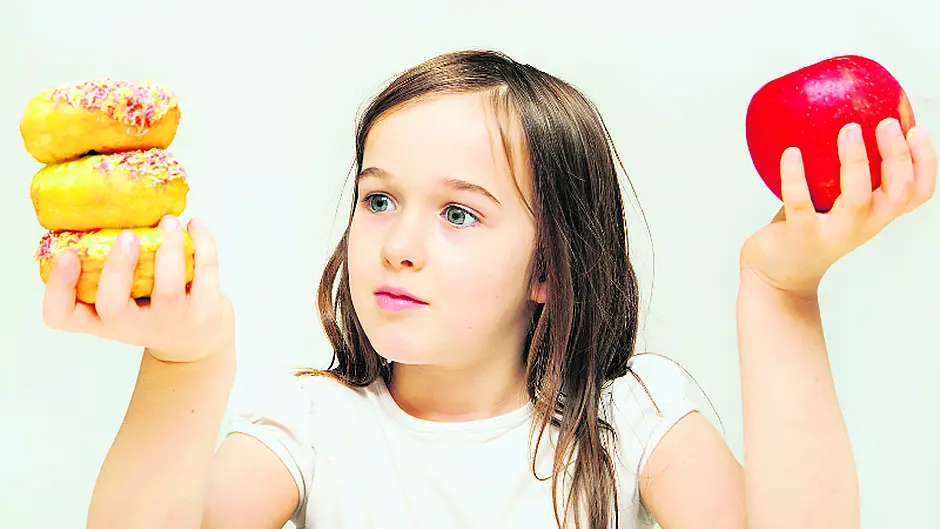Health and Nutrition with Rosie Shelley
Following on from my pregnancy piece, I thought I should talk about what our children are eating. And what they’re eating has never been more important than it is now, with alarming statistics emerging at every turn: Ireland has one of the highest rates of childhood obesity in the world. One in four children is overweight or obese, and some of them are showing early signs of cardiovascular disease.
Type 2 diabetes, which is lifestyle-related, is no longer called Adult-onset diabetes for the simple reason that it is now affecting youths. The link between extra weight and some cancers is well established, and studies show that adults with the most severe degrees of obesity were likely to have become overweight before the age of ten.
Other research points to the paradox that, although many children are eating too much, they are far from well fed, though it’s not really surprising when you consider that on average one fifth of their energy intake comes from junk food. 94% of them eat far too much saturated fat, and the sugar and salt content of these ‘foods’ are a huge problem. Among the widespread nutritional deficiencies of young people are the minerals iron, zinc and calcium. This last is of particular importance in childhood because it’s then that bone strength is laid down. Kids who eat a lot of calcium are also less likely to die from a stroke in adulthood, and 25% less likely to have died from any cause by the time they’re 65. Dairy foods are the best-known source of calcium, but it can also be found in seeds and nuts, canned fish, beans, green vegetables and dried fruit.
Of course young people naturally gravitate towards high-energy, sweet or salty and fatty foods, and there’s no need to stress as long as they’re active, and eating much more of the good stuff than the junk. Nothing should be banned outright, because it only makes it more attractive, but there are a few things that are better kept out of their way. The trans fats found in some margarine and spreads, biscuits, cakes and crisps, are bad news for the heart; food additives (E numbers) can cause or exacerbate behavioural problems and allergic reactions, and some are carcinogenic; processed meat products like sausages and hot dogs have been linked with bowel cancer; fizzy drinks often contain caffeine—an addictive drug—either a lot of sugar or nasty sweeteners, and they rot children’s teeth and rob their bones of that precious calcium.
When it comes to packaged snacks and meals, even those marketed as healthy can be shockingly high in the unholy trinity of sugar, salt and fat. Some cereal bars are almost one-third sugar. The trick is to make homemade versions that are tasty and attractive—potato wedges or roast parsnip sticks instead of chips, root vegetables sliced wafer thin and roasted instead of crisps, homemade burgers, fish fingers and chicken nuggets. Pulses like beans and lentils, as well as a variety of pureed vegetables, can be sneaked into soups, sauces, dips, mashed potato, curries and chillis, which some children are surprisingly open to, and gram flour (ground chickpeas), can often replace white flour. It can be quite easy, and especially important where older children are concerned, to replace the white—flour, bread, pasta, rice—with the brown or wholemeal, or try them with couscous or highly nutritious quinoa instead.
And summer is the time to get them active outside, burning off that energy and boosting their young bones and hearts and vitamin D levels.
Cycle to the beach for a picnic, go for a swim, kick a ball around, make it fun. And if they sleep soundly as a result, even better—a final statistic for you is that young children who slept an hour longer than their peers were found to have a 61% reduced risk of being overweight.
Child Friendly Foods
Breakfasts: porridge with banana and honey; low sugar muesli; unsweetened breakfast cereals with fruit; fruit, egg and soldiers; pancakes with berries and maple syrup; fruit smoothies (slip in some ground seeds for a healthy boost)
Lunches: wholemeal sandwiches with tuna or chicken, sweetcorn and mayo, turkey and coleslaw, tinned fish and tomato, nut butter and cucumber, or hummus and red pepper; beans on toast with salad; omelette and salad; salad made with tomatoes, tuna or chickpeas, and rice/pasta/couscous/quinoa
Snacks: fruit or dried fruit; nuts; homemade muffins, oat slices or biscuits; popcorn; rye crackers/rice cakes/oatcakes with cheese, hummus or nut butter; homemade root vegetable crisps; homemade ice lollies
Dinners (all with a side of vegetable): homemade pizza; lasagne or spaghetti bolognese; pasta or rice with prawns and peas; macaroni cheese; chilli or curry with rice; meat or fish and potatoes; quiche or cheese soufflé; fish or meat kebabs and rice; homemade beef or bean burgers with a wholemeal bun; shepherds/cottage pie or meat loaf; homemade crumbed chicken or fish goujons with potato wedges; fish cakes; baked potatoes with cheese, wbeans or tuna
Desserts: fruit salad or stewed fruit and icecream, fruit pureed with thick natural yoghurt, fruit in jelly, organic fruit fromage frais, fruit crumble with yoghurt, homemade rice pudding, banana splits with chopped nuts and icecream.







